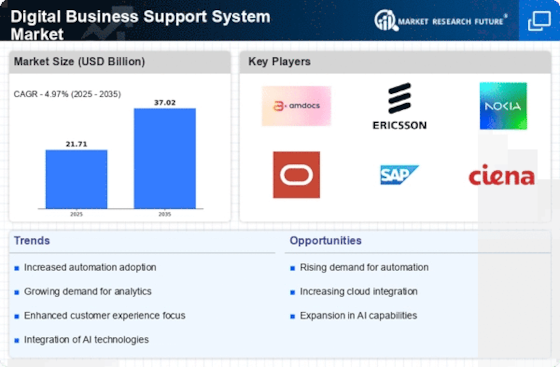Rising Demand for Automation
The Digital Business Support System Market is experiencing a notable surge in demand for automation solutions. Organizations are increasingly seeking to streamline operations, reduce manual intervention, and enhance efficiency. Automation technologies, such as robotic process automation (RPA) and intelligent automation, are being integrated into business processes. This trend is driven by the need for faster service delivery and improved accuracy. According to recent data, the automation segment within the Digital Business Support System Market is projected to grow at a compound annual growth rate (CAGR) of approximately 15% over the next five years. This growth reflects a broader shift towards digital transformation, where businesses aim to leverage technology to optimize their operations and remain competitive.
Growing Focus on Data Analytics
In the Digital Business Support System Market, the emphasis on data analytics is becoming increasingly pronounced. Organizations are recognizing the value of data-driven decision-making and are investing in analytics tools to gain insights into customer behavior, operational efficiency, and market trends. The integration of advanced analytics capabilities into business support systems allows companies to harness vast amounts of data, leading to more informed strategies. Recent statistics indicate that the analytics segment is expected to account for over 30% of the overall market share in the Digital Business Support System Market by 2026. This trend underscores the importance of leveraging data to enhance business performance and customer satisfaction.
Shift Towards Cloud-Based Solutions
The Digital Business Support System Market is witnessing a significant shift towards cloud-based solutions. Organizations are increasingly adopting cloud technologies to enhance flexibility, scalability, and cost-effectiveness. Cloud-based business support systems enable companies to access critical applications and data from anywhere, facilitating remote work and collaboration. This transition is supported by the growing need for businesses to adapt to changing market conditions and customer demands. Data suggests that the cloud segment is anticipated to grow at a CAGR of around 20% in the Digital Business Support System Market over the next few years. This growth reflects the ongoing digital transformation efforts across various sectors.
Increased Regulatory Compliance Requirements
The Digital Business Support System Market is also influenced by the rising regulatory compliance requirements across various sectors. Organizations are compelled to adhere to stringent regulations regarding data protection, financial reporting, and operational transparency. As a result, there is a growing demand for business support systems that can facilitate compliance management and reporting. Companies are investing in solutions that provide real-time monitoring and reporting capabilities to ensure adherence to regulations. This trend is likely to drive the growth of the compliance segment within the Digital Business Support System Market, as businesses seek to mitigate risks associated with non-compliance and enhance their reputational standing.
Emergence of Customer Experience Management Solutions
The Digital Business Support System Market is increasingly focusing on customer experience management (CEM) solutions. Organizations are recognizing that enhancing customer satisfaction is crucial for retaining clients and driving revenue growth. CEM solutions enable businesses to gather feedback, analyze customer interactions, and personalize services. This trend is indicative of a broader shift towards customer-centric strategies, where organizations prioritize understanding and meeting customer needs. Recent market analysis indicates that the CEM segment is expected to grow significantly, potentially reaching a market share of 25% within the Digital Business Support System Market by 2027. This growth reflects the importance of delivering exceptional customer experiences in a competitive landscape.

















Leave a Comment